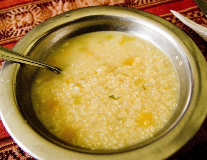Selection and Storage
Dry quinoa seeds, whether raw or processed, are readily available year-round in US stores. Since quinoa is not a conventional crop in the USA, it must be imported from Bolivia, Peru, and other South American countries. Processed seeds are typically sold in airtight packets and bulk bins.
Look for fine, dry grains roughly the size of pearl millet. They come in various colors, ranging from creamy-white, pink, yellow to deep brown, depending on the cultivar variety.
At home, store the grains in an airtight container in a cool, dry place to keep them fresh for several months. However, ground quinoa flour exposes its essential fatty acids to environmental factors, which can lead to rapid lipid peroxidation and reduce its shelf life. Therefore, grind it as needed and store the flour in an airtight container.
Preparation and serving methods

|
| Sopa de quinua- quinua soup. Photo courtesy: Robert Luna |
The unprocessed quinoa grain has a thick outer coat (hull) which makes it unsuitable for consumption and must be removed before cooking. saponin that imparts a bitter, soapy taste. Practically all quinoa grains available in US stores have been de-hulled and pre-washed.
At home, wash in cold water repeatedly until all of its foam disappears before cooking. Quinoa is cooked in the same way as you cook other staples like buckwheat, rice, etc. Roughly, one cup of dry grains cooks to three cups. Cooked quinoa becomes fluffy, and chewy and attains pearl-like translucency and a pleasant taste.
Here are some serving tips:
-
Combining quinoa flour with other cereal flours such as maize, wheat, oats, etc., enhances the overall protein quality of the meal, compensating for the limited amino acid levels in grains.
-
Traditionally, native Andeans used quinoa seeds to prepare porridge and soup, and they milled them into flour to make bread, porridge (lawa), buns, polenta, and non-alcoholic cold drinks (quinua chicha).
-
Elsewhere in the world, quinoa grains are used in various ways, similar to other cereal grains, to make pilaf, porridge, flakes, puddings, etc.
-
Its flour can be utilized in numerous ways to make bread, buns, cakes, pasta, noodles, cookies, biscuits, etc.
-
Young, tender quinoa leaves (chiwa) and flower heads are also consumed as leafy vegetables and indeed make good salads, stews, and soups when mixed with amaranth, spinach, and beet leaves.
-
Cold-pressed quinoa oil has become one of the sought-after as a dressing as well as a cooking oil, replacing rice bran or corn oils.
Safety Profile
Unpolished (unwashed) quinoa seeds contain saponin, a triterpenoid compound found in their outer cover. Saponin has a bitter, soap-like taste that, when consumed, may lead to stomach pain, flatulence, and laxative diarrhea. Naturally, this protective covering over the grains helps safeguard them from insects and birds.
Quinoa leaves and flower heads contain oxalic acid and should be blanched in boiling water before consumption. (Medical disclaimer).
≺≺ Back to Nuts and seeds from Quinoa. Visit here for an impressive list of nuts and seeds with complete illustrations of their nutrition facts and health benefits.
≺≺ Back to Home page.
Further Resources:

